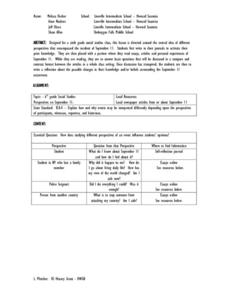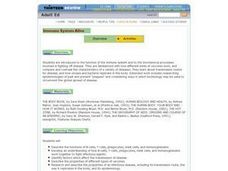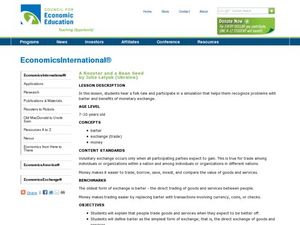Curated OER
Macbeth
Students discuss the changes the characters go through in Shakespeare's play Macbeth. They discuss the themes of the play write an essay comparing current events to the themes of the play.
Curated OER
The Incident of September 11th
Sixth graders identify and write in their journals in order to activate prior knowledge on the events that surround September 11th. Students, with a partner, read various essays, articles and personal experiences of September 11....
Curated OER
Figurative Language - Part Two
Pupils need to use their papers from Part One of this lesson. They then write a paragraph for each term. This exercise help them to use these terms in their writing. Using figurative language makes writing more descriptive and alive.
Curated OER
Exploring & Creating Mythology
Students read and compare mythological stories from ancient cultures from around the world. In small groups they read a myth and present the storyline and themes to the class, and write an original mythological story of their own...
Curated OER
Science vs. Science Fiction
Students acknowledge the difference between science and science fiction through a compare/contrast activity. They discuss their reading materials together. Students identify characteristics specific to science fiction.
Curated OER
Why a Bill of Rights? What Impact Does it Have?
Students explore the Bill of Rights. In this Bill of Rights lesson, students compare the Federalist view of government to the Anti-Federalist view of government. Students consider the impact of the bill of rights as they take notes on...
Curated OER
From Whose Perspective?
Students critically analyze news coverage of Palestinian-Israeli violence by comparing information from a variety of news sources. They compose expository essays reflecting on how to obtain accurate, unbiased, and credible information.
Curated OER
What is an Organism?
Sixth graders take a pre-test and summarize teacher's discussion of cells, tissues, organs in their notebooks. They read selections on organisms in their textbook and perform a dissection of a chicken drumstick with the thigh attached....
Curated OER
Immune System Alive
Young scholars examine the function of the immune system. They read and discuss text, complete a K-W-L chart, sequence photos of white blood cells encountering bacteria, develop an outline, and write an essay.
Curated OER
Window Into Another Culture
Students read "A Single Lucid Moment" as a class. In groups, they identify the aspects of the United States that might allow for homelessness to happen and compare it with the culture of New Guinea. They write a journal entry about how...
Curated OER
Exploring Cultural Rituals
Students analyze images and music of common rituals in America with those of other countries. They use worksheets to compare and contrast the events.
Curated OER
In a Galaxy Far, Far, Far Away
Sixth graders compare distances between objects in the solar system. They investigate how light years are measured and when using them to measure how distances compare with one another. They write an essay exploring the possibility of...
Curated OER
Feudalism and the Magna Carta
Young scholars compare the Magna Carta and the Bill of Rights. In this historical comparison lesson, students examine primary sources of three significant historical documents. Young scholars create a chart in a compare and contrast...
Curated OER
Fiction vs. Nonfiction
Young scholars explore fiction and nonfiction writing. They identify the elements of fiction in a short story and identify the criteria necessary in a nonfiction piece. Students distinguish the author's purpose in an expository text,...
Curated OER
Independence Masks
Young scholars explore how art reflects the economic, political, social, religious and historical concerns of a culture. They research a former colony to determine if there is any history of a mask. Students create a mask representing...
Curated OER
Fictional Hereos
Students are introduced to the definition of a hero. As a class, they compare and contrast the difference between non-fictional and fictional hereos they have read about. They read a story, create a story map of one of the heroes and...
Curated OER
Chinese Dynasties
Students explore several Chinese dynasties and research various topics including papermaking, calligraphy, and Lu Hou. They also demonstrate how to use an abacus and create several math problems to solve with it. Choosing a dynasty,...
Curated OER
Whose Head Goes Here?
Students research the Illinois quarter and the President on it. Students research President Lincoln and American coinage. Students compare this quarter to the other national quarters with Presidents on them.
Curated OER
U.S. History: What Happened Here?
Students apply the global positioning system to create maps of local historical sites. By collaborating with local historical groups, they research events and relate them to broader, national history. In addition to writing essays...
Curated OER
Marriage Equality: Different Strategies for Attaining Equal Rights
Pupils examine gays rights issues in the United States. In this gay marriage lesson, students investigate how people have made their cases before the executive, legislative, and judicial branches of government to secure their civil...
Curated OER
Indians and White Americans
In this American history worksheet, students complete a chart comparing 6 aspects of American Indian and White American culture. Students then answer 2 essay questions.
Curated OER
A Rooster and a Bean Seed
Young scholars study exchange and how it has different forms. In this money management lesson, students are able to learn how goods and services work by completing worksheets, activities, essay questions and assessments provided.
Novelinks
The Devil’s Arithmetic: Semantic Feature Analysis
Organize the characters in Jane Yolen's The Devil's Arithmetic according to their shared character traits. After listing character traits as a class, kids note which characters exhibit particular characteristics with a discussion and...
Curated OER
Spanish/American Comparison
Students compare Spanish and American cultures. For this global studies lesson, students review what they have learned in a Spanish culture unit by writing compare and contrast essays about Spanish and American cultural aspects.

























